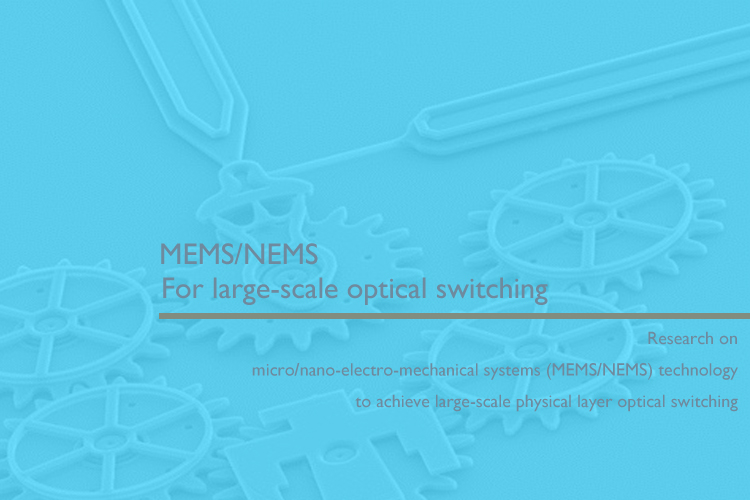Micro/Nano-electro-mechanical systems for large-scale optical switching
Research on micro/nano-electro-mechanical systems (MEMS/NEMS) technology
to achieve large-scale physical layer optical switching
Introduction
The demand for high-speed and efficient communication networks has been growing rapidly in recent years. As a result, researchers and engineers have been exploring various technologies to enhance the capabilities of optical networks. One such technology that has gained significant attention is Micro/Nano-Electro-Mechanical Systems (MEMS/NEMS). This article delves into the research and advancements in MEMS/NEMS technology for achieving large-scale physical layer optical switching.

1.Understanding Micro/Nano-Electro-Mechanical Systems (MEMS/NEMS):
Micro/Nano-Electro-Mechanical Systems (MEMS/NEMS) involve the integration of mechanical, electrical, and optical components at the micro and nano-scale. These systems utilize tiny movable structures, such as mirrors or switches, which can be electrically controlled to perform various functions, including optical switching.
2.Advantages of MEMS/NEMS in Large-Scale Optical Switching:
2.1 Miniaturization and Scalability: MEMS/NEMS devices enable the scaling down of optical components, allowing for the integration of a large number of devices on a single chip. This miniaturization leads to increased port density and reduced power consumption, making it feasible for large-scale optical switching applications.
2.2 High-Speed Switching: MEMS/NEMS devices offer ultra-fast switching speeds, with response times in the nanosecond range. This enables efficient routing and switching of optical signals in real-time, meeting the demands of high-speed communication networks.
2.3 Low Insertion Loss and Crosstalk: The advanced design and fabrication techniques used in MEMS/NEMS devices result in low insertion loss and crosstalk, ensuring minimal signal degradation during switching operations. This is crucial for maintaining signal integrity in large-scale optical networks.
3.Research on MEMS/NEMS Technology for Large-Scale Optical Switching:
3.1 Design and Fabrication Techniques: Researchers have been investigating novel design and fabrication techniques to improve the performance and reliability of MEMS/NEMS devices for optical switching. This includes the use of advanced materials, such as silicon, silicon nitride, or polymers, and the integration of optical waveguides for efficient light manipulation.
3.2 Actuation Mechanisms: Efficient actuation mechanisms are crucial for achieving reliable and precise optical switching. Researchers are exploring various actuation techniques, including electrostatic, electromagnetic, piezoelectric, and thermal actuation, to enable controlled movement of MEMS/NEMS devices.
3.3 Reliability and Durability: To ensure the practical implementation of MEMS/NEMS-based optical switches, extensive research is being conducted to enhance the reliability and durability of these devices. This involves addressing issues such as stiction, fatigue, and long-term stability, which can affect the performance and lifespan of the devices.
Conclusion
In conclusion, the research on Micro/Nano-Electro-Mechanical Systems (MEMS/NEMS) technology for large-scale optical switching holds immense promise for revolutionizing the physical layer of optical networks. The advantages of MEMS/NEMS devices, including miniaturization, high-speed switching, and low signal degradation, make them ideal for meeting the ever-increasing demands of modern communication networks.
FAQs:
Q1. What is the significance of MEMS/NEMS in optical switching?
A1. MEMS/NEMS enables miniaturization, high-speed switching, and low signal degradation, making it ideal for large-scale optical switching applications.
Q2. How do MEMS/NEMS devices achieve optical switching?
A2. MEMS/NEMS devices utilize movable structures, such as mirrors or switches, which can be electrically controlled to redirect or switch optical signals.
Q3. Are MEMS/NEMS devices reliable for long-term use?
A3. Extensive research is being conducted to enhance the reliability and durability of MEMS/NEMS devices, addressing issues such as stiction, fatigue, and long-term stability.
Q4. What are the challenges in implementing MEMS/NEMS-based optical switches?
A4. Challenges include designing efficient actuation mechanisms, integrating optical waveguides, and ensuring long-term reliability and durability of the devices.
Q5. How does MEMS/NEMS technology contribute to the future of optical networks?
A5. MEMS/NEMS technology offers the potential for highly efficient, high-speed, and scalable optical networks, paving the way for advanced communication systems.
Keywords: Micro/Nano-Electro-Mechanical Systems, MEMS/NEMS, large-scale optical switching, optical networks, miniaturization, high-speed switching, insertion loss, crosstalk, design and fabrication techniques, actuation mechanisms, reliability, durability.

 The Future of Fiber Optic Communication Network Architecture: Evolution and the Role of SDON Technology
The Future of Fiber Optic Communication Network Architecture: Evolution and the Role of SDON Technology
 What opportunities and challenges does free-space optical communication technology face?
What opportunities and challenges does free-space optical communication technology face?
 Opelink MPO Products for High-Speed Data Center Applications
Opelink MPO Products for High-Speed Data Center Applications
 CWDM vs. DWDM: Which Optical Transmission Technology Should You Choose?
CWDM vs. DWDM: Which Optical Transmission Technology Should You Choose?